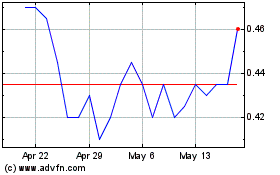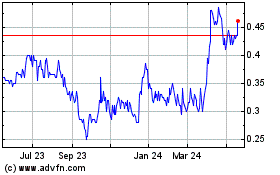Northland Cuts 43% Iron Over 53m at Salmivaara, Sweden
January 14 2008 - 8:15AM
Marketwired
VANCOUVER, BRITISH COLUMBIA (FRANKFURT: NBS)(OSLO: NAUR) is
pleased to announce encouraging drill results from 6 diamond core
holes completed at the Company's 100% owned Salmivaara iron-copper
project, located approximately 33km northeast of the city of
Gallivare in Nortbotten county, Sweden. All holes returned multiple
intersections of magnetite, with downhole thickness of up to nearly
150m locally.
The near-surface Salmivaara magnetite body is within 1km of a
sealed road and approximately 33km from a rail line that carries
iron ore trains from Europe's second largest iron ore mine,
Malmberget, which is operated by the Swedish state-owned mining
company LKAB.
Highlights of the new drill results, which support and build on
results from 12 historic diamond core holes completed by the
Swedish Geological Survey (SGU), include:
- Hole 07001 42.8% Fe + 0.12% Cu over 52.7m from 15.3m downhole
- Hole 07004 35.5% Fe + 0.10% Cu over 53.9m from 41m downhole
- Hole 07005 46.5% Fe + 0.12% Cu over 49.2m from 97.8m downhole
- Hole 07006 35.3% Fe + 0.12% Cu over 147.3m from 89.9m downhole
Buck Morrow, the President of Northland, said, "The successful
Salmivaara drill program is a continuation of Northland's strategy
to define combined resources of more than 500 million tonnes of
magnetite at the Company's iron projects in northern Europe. Our
drilling cut substantial magnetite mineralization below the limits
of the historical work - a very promising start to our exploration
at Salmivaara. We are planning additional drilling this winter to
further define the Salmivaara magnetite bodies and will begin
metallurgical testwork."
A full table of Northland's results is given below. Northland's
holes were drilled on 3 profiles: Holes 001, 002 and 004 form one
profile, holes 005 and 006 are on another and hole 003 was drilled
on the same profile has historic hole 70801.
All holes were drilled at an angle of -50 degrees. Mineralized
widths in the table below are downhole widths and not true widths.
The information available suggests that the magnetite bodies are
steeply dipping and therefore the true thickness of the magnetite
is likely to be less than the downhole mineralized intervals. Assay
intervals were calculated based on an assumed cut off grade of 15%
Fe. Drill sections will be posted shortly on Northland's website at
www.northlandresourcesinc.com.
--------------------------------------------------------------------
From To Width
Hole No. (m) (m) (m) Fe % Cu % S %
--------------------------------------------------------------------
SAL07001 15.3 68.0 52.7 42.8 0.12 3.28
and 98.7 128.3 29.6 34.2 0.08 2.72
and 136.8 216.9 80.1 33.7 0.17 4.18
including 136.8 178.6 41.8 39.3 0.24 5.39
SAL07002 64 137.6 73.6 34.2 0.12 2.87
and 206.8 256.2 49.4 27.6 0.06 2.08
including 92.2 117.2 25.0 48.3 0.18 4.21
SAL07004 41.1 95.0 53.9 35.5 0.10 3.15
and 160.0 203.3 43.3 32.6 0.14 3.70
SAL07005 73.7 155.0 81.3 40.4 0.09 2.27
and 250.4 292.7 42.3 28.8 0.15 4.1
including 97.8 147.0 49.2 46.5 0.12 3.17
SAL07006 40.4 68.0 27.6 32.0 0.04 1.81
and 89.9 237.2 147.3 35.3 0.12 2.57
and 305.2 355.4 50.2 26.8 0.09 2.29
including 153.6 211.6 58.0 44.6 0.23 4.82
SAL07003 56.1 64.8 8.7 43.02 0.14 3.74
--------------------------------------------------------------------
The SGU's interpretation of multiple, steeply-dipping magnetite
bodies within a large synformal fold structure is supported by
Northland's drilling, where the magnetite bodies appear to be
thickest and highest grade in the core of the synform, showing
multiple intervals of greater than 40% Fe over 10s of metres, and
locally greater than 50% Fe (e.g. drillholes SAL07001, 07005 and
07006 - drillhole 07006 returned 20.9m of 52.5% Fe from 191m
downhole).
Mineralization at Salmivaara consists of magnetite with pyrite,
pyrrhotite and chalcopyrite. It was discovered in 1897, first
drilled in 1904, and was mined for copper during World War II. The
Swedish Geological Survey (SGU) worked on the deposit between 1967
and 1971, publishing a report titled "Salmivaara Iron Occurrence"
and describing the deposit in the Swedish Iron Ore Inventory. A
total of 12 holes were drilled, for 1,818m of core drilling to a
maximum depth of 120m below surface, and the SGU completed magnetic
and gravimetric studies which indicate that the magnetite body may
continue to a depth of at least 700m below surface.
Northland has compiled the available historic drill data. The
mineralized intercepts reported by the SGU are as follows:
-------------------------------------------------------
From To Width
Hole No. (m) (m) (m) Fe %
-------------------------------------------------------
SAL71801 112 426 314 25.8
SAL71802 80 142 62 23.5
SAL40001 22.9 78.4 55.5 22.8
SAL40002 14.7 37 22.3 31.3
SAL40005 24.6 44.5 19.9 45.0
SAL40006 28.9 163.3 134.4 24.2
SAL40007 21.7 85.3 63.6 46.1
-------------------------------------------------------
Based on drilling, the SGU published an estimated resource of 16
million tonnes grading approximately 34% iron with between 0.1 to
0.8% Cu. Sulphur content averages 3.6% with 0.03% phosphorous. The
reader is cautioned that this historic resource does not comply
with the standards set out in NI43-101 and cannot therefore be
relied upon. Northland is currently carrying out the work required
to verify the historic resource.
Assay Protocol
The core was cut at Northland's core facility in Kolari,
Finland. A one half split core from Salmivaara was prepared at ALS
Chemex Lab in Pitea, Sweden and then transported to ALS Chemex
Vancouver, British Columbia Canada for analysis.
Copper and Iron were analyzed by Sodium Peroxide Fusion multi
element analysis, ICP-AES Method ME-ICP81. Gold was analyzed by
Lead Fire Assay Pre-concentration with ICP-AES Method Au-ICP21
finish.
In addition to the ALS Chemex internal sample preparation and
assay QC protocol, Northland maintains a rigorous QA/QC program
consisting of inserting blanks, duplicates and certified standards
to the analytical process.
Qualified Person
The technical information in this release was prepared under the
supervision of Mr. David Cass, who is a member of the Association
of Professional Engineers and Geoscientists of British Columbia,
and a "Qualified Person" in accordance with National Instrument
43-101.
About Northland (www.northlandresourcesinc.com)
Northland is a well-structured, debt free junior exploration
company with a portfolio of high quality iron, gold, and base metal
exploration projects in Sweden and Finland.
ON BEHALF OF THE BOARD
Buck Morrow
NORTHLAND RESOURCES INC.
The TSX Venture Exchange does not accept responsibility for the
adequacy or accuracy of this release.
Contacts: Northland Resources Inc. Buck Morrow President Toll
Free: 1-866-719-8962 Northland Resources Inc. Ralph Rushton
Investor Relations - North America Toll Free: 1-866-719-8962
Northland Resources Inc. Gabriella Roos Investor Relations - Europe
+44 791 286 9936 Website: www.northlandresourcesinc.com
Nevgold (TSXV:NAU)
Historical Stock Chart
From May 2024 to Jun 2024

Nevgold (TSXV:NAU)
Historical Stock Chart
From Jun 2023 to Jun 2024
